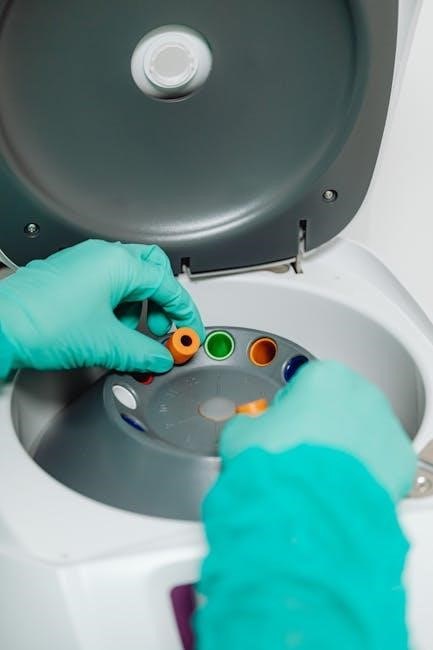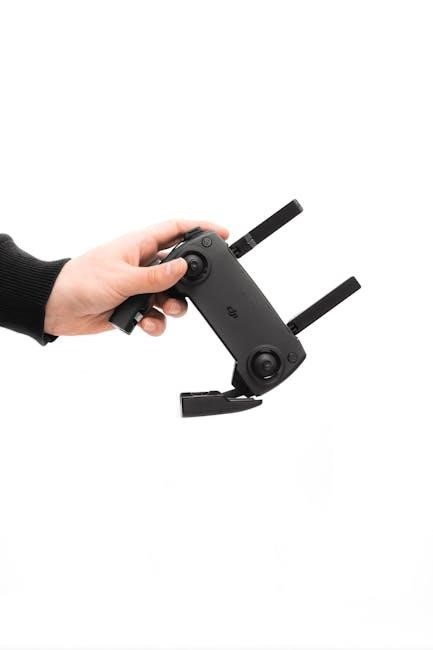danfoss controller manual
This manual provides a comprehensive guide to Danfoss controllers‚ covering installation‚ operation‚ and troubleshooting. It serves as a roadmap for successful operation‚ ensuring optimal performance and efficiency.
1.1 Overview of Danfoss Controllers
Danfoss controllers are advanced devices designed to regulate and optimize refrigeration and HVAC systems. They offer precise temperature control‚ energy efficiency‚ and seamless integration with various applications. Models like the AK-CC 550‚ AK-PC 781A‚ and ERC 211 provide smart multipurpose refrigeration control‚ while the Optyma Plus focuses on condensing units. These controllers support features like defrost cycle management‚ fan control‚ and data communication‚ ensuring reliable operation. They are widely used in commercial refrigeration‚ industrial processes‚ and building management systems‚ offering flexibility and adaptability to meet diverse user needs.
1.2 Importance of the Manual for Users
This manual is essential for users to understand and utilize Danfoss controllers effectively. It provides detailed instructions for installation‚ configuration‚ and troubleshooting‚ ensuring optimal performance. The guide helps users navigate advanced features like defrost cycles‚ fan control‚ and data communication. By following the manual‚ users can customize settings‚ resolve common issues‚ and maintain system efficiency. It serves as a critical resource for both novice and experienced operators‚ enabling them to maximize the controller’s capabilities and ensure reliable operation across various applications.

Types of Danfoss Controllers
Danfoss offers a range of controllers for various applications. Key models include the AK-CC 550‚ AK-PC 781A‚ ERC 211‚ and Optyma Plus‚ each designed for specific refrigeration and climate control needs.
2.1 AK-CC 550 Controller
The AK-CC 550 is a versatile controller designed for advanced refrigeration systems. It supports defrost management‚ fan control‚ and data communication‚ ensuring efficient operation. Suitable for various applications‚ it offers precise temperature regulation and compatibility with Danfoss systems. Its user-friendly interface and robust features make it ideal for commercial refrigeration needs‚ providing reliable performance and energy efficiency. The controller is preprogrammed for universal use but allows parameter adjustments for specific requirements. It integrates seamlessly with ADAP-KOOL systems‚ enhancing overall system control and monitoring capabilities.
2.2 AK-PC 781A Controller
The AK-PC 781A is a high-performance capacity controller designed for refrigeration systems. It features advanced defrost management‚ fan control‚ and data communication options. Part of the ADAP-KOOL system‚ it ensures efficient operation and energy savings. The controller supports various applications‚ including commercial refrigeration‚ and offers precise temperature regulation. Its compatibility with Danfoss systems enhances overall performance. With user-friendly programming and robust features‚ the AK-PC 781A is ideal for demanding environments‚ providing reliable control and monitoring capabilities for optimal system efficiency.

2.3 ERC 211 Controller
The ERC 211 is a smart‚ multipurpose refrigeration controller designed for versatility and efficiency. Part of the ERC 21X series‚ it offers advanced control solutions for various refrigeration applications. Compatible with systems like ERC 214 and ERC 213‚ it ensures seamless integration and operation. The ERC 211 supports precise temperature management‚ defrost cycles‚ and fan control‚ making it ideal for commercial and industrial settings. Its user-friendly interface and robust features provide reliable performance. The controller is well-documented‚ with a comprehensive manual available for detailed guidance and troubleshooting.
2.4 Optyma Plus Controller
The Optyma Plus Controller is an advanced solution designed for efficient refrigeration control. It offers enhanced connectivity and compatibility with self-contained rooms‚ remote condensing units‚ and rack systems. This controller features fan control methods‚ including manual and automatic settings‚ ensuring optimal energy efficiency. Its compact design and precise control capabilities make it ideal for various commercial applications. The Optyma Plus supports seamless integration with existing systems‚ providing reliable performance and adaptability. Regular updates and comprehensive documentation ensure users can maximize its functionality and maintain efficiency in their operations.
Installation and Setup
Installation and setup of Danfoss controllers involve hardware mounting‚ wiring connections‚ and initial configuration. Ensure compatibility with existing systems for smooth operation and optimal efficiency.
3.1 Hardware Installation Steps
Hardware installation involves preparing the site‚ mounting the controller‚ and connecting sensors. Choose a suitable location for the controller‚ ensuring accessibility and protection from harsh conditions. Mount the device using clips‚ front mounting‚ or integrated solutions‚ depending on the model. Install sensors like evaporator and air sensors‚ ensuring correct placement for accurate readings. Connect the sensors to the controller‚ following the wiring diagram. Verify compatibility with existing systems and ensure all connections are secure. Refer to the manual for specific mounting and wiring instructions to ensure proper installation and functionality.
3.2 Wiring and Connections
Proper wiring is essential for controller functionality; Follow the wiring diagram provided in the manual to connect sensors‚ compressors‚ and fans. Ensure all connections are secure and match the controller’s terminals. Use appropriate cables for power supply and signal transmission. Connect sensors like evaporator and air sensors according to their designated ports. Verify polarity to avoid damage. Test connections before powering up to ensure integrity. Refer to the manual for specific wiring instructions tailored to your controller model‚ ensuring safe and reliable operation of the system.

3.3 Initial Setup and Configuration
Begin by powering on the controller and following the startup sequence outlined in the manual. Use the KoolProg software or the controller’s keypad to navigate through menus and set parameters. Configure basic settings like temperature ranges‚ defrost intervals‚ and fan control modes. Refer to the manual for default settings or adjust based on specific requirements. Save configurations to ensure they are retained. For advanced setups‚ connect to a PC using KoolProg for precise adjustments. Test the system to ensure all functions operate correctly before full deployment. This step ensures optimal performance and customization for your application.

Programming the Controller
Programming involves setting parameters and configurations using KoolProg software or the controller’s interface. Adjust settings like temperature‚ defrost cycles‚ and fan control for optimal performance.
4.1 Programming Overview
Programming a Danfoss controller involves configuring parameters to meet specific operational needs. Using KoolProg software‚ users can adjust settings like temperature setpoints‚ defrost cycles‚ and fan control. The process ensures optimal performance by tailoring the controller to the system’s requirements. Parameters can be fine-tuned for tasks such as compressor operation‚ sensor inputs‚ and data communication. Advanced features like automatic defrost timing and energy-saving modes can also be enabled. The software provides a user-friendly interface for uploading configurations and monitoring real-time data‚ ensuring precise control over refrigeration systems. This step is crucial for achieving efficient and reliable operation.
4.2 Parameter Settings and Adjustments
Parameter settings in Danfoss controllers allow precise customization of system behavior. Adjustments can be made to optimize performance‚ such as modifying temperature thresholds‚ compressor timing‚ and fan operation. Key parameters include defrost intervals‚ sensor calibration‚ and energy-saving modes. These settings ensure the controller adapts to specific applications‚ improving efficiency and reliability. Advanced parameters may require specialized tools or software‚ like KoolProg‚ for accurate configuration. Proper adjustments are critical to maintain optimal system operation and prevent issues like overheating or excessive energy consumption. Regular reviews of parameter settings are recommended to ensure ongoing performance.
4.3 Using KoolProg Software for Programming
KoolProg software is a powerful tool for programming Danfoss controllers‚ offering an intuitive interface for parameter configuration and advanced control. It enables real-time monitoring‚ data logging‚ and customization of settings to meet specific application needs. With KoolProg‚ users can easily adjust parameters‚ upload/download configurations‚ and perform firmware updates. The software supports a wide range of Danfoss controllers‚ ensuring compatibility and flexibility. It streamlines the programming process‚ reducing complexity and saving time. Regular updates to KoolProg ensure access to the latest features and improvements for optimal controller performance.
Operation and Functionality
Danfoss controllers offer advanced operation and functionality‚ including cooling control modes‚ defrost cycle management‚ fan control methods‚ and data communication options‚ ensuring efficient and adaptive performance.
5.1 Cooling Control Modes
Danfoss controllers offer multiple cooling control modes to optimize performance. These include continuous operation‚ cyclic defrost‚ and adaptive control. Continuous mode ensures steady cooling‚ while cyclic defrost prevents ice buildup. Adaptive control adjusts cooling based on demand‚ enhancing efficiency. These modes ensure precise temperature management‚ reducing energy consumption and extending equipment lifespan. Users can select modes via the control panel or KoolProg software‚ tailoring operations to specific applications. Proper mode selection is crucial for maintaining optimal conditions and system reliability.

5.2 Defrost Cycle Management
Danfoss controllers feature advanced defrost cycle management to prevent ice buildup and maintain efficiency. Users can manually activate or deactivate defrost‚ with options to adjust defrost duration and frequency. The system automatically detects when defrost is needed‚ ensuring optimal performance. If issues arise‚ such as defrost not starting‚ the controller provides error codes for troubleshooting. Proper defrost management extends equipment lifespan and maintains consistent cooling. Adjustments can be made via the control panel or KoolProg software‚ offering flexibility for various applications. This ensures reliable operation and energy efficiency in refrigeration systems.
5.3 Fan Control Methods
Danfoss controllers offer versatile fan control methods to optimize system performance. Modes include “Fan Always On‚” “Fan Follow Compressor‚” and “Automatic Fan Control.” These settings allow customization based on specific applications. Automatic control adjusts fan speed dynamically‚ reducing energy consumption. Manual overrides enable precise adjustments for unique scenarios. Fan speed can also be controlled externally or through internal parameters. Delays for fan start and stop ensure smooth operation. These methods enhance efficiency‚ reduce wear on components‚ and provide consistent cooling. Proper fan control is essential for maintaining optimal refrigeration system performance and energy savings.
5.4 Data Communication Options
Danfoss controllers support advanced data communication options for seamless system integration. They are compatible with ADAP-KOOL refrigeration control systems‚ enabling efficient data exchange. RS-485 communication is commonly used for connecting multiple controllers. The controllers can also integrate with Building Management Systems (BMS) for centralized monitoring. Remote access and monitoring are possible through dedicated software tools. Additionally‚ the Danfoss KoolCode app provides mobile access to controller settings and real-time data. These communication options enhance system control‚ improve efficiency‚ and allow for remote troubleshooting‚ ensuring optimal performance across connected systems.

Troubleshooting Common Issues
This section addresses common operational problems‚ such as defrost issues and error codes‚ providing solutions and guidance for resolving them efficiently using Danfoss tools and resources.
6.1 Common Operational Issues
Common issues with Danfoss controllers include defrost cycles not starting‚ fan control malfunctions‚ and sensor connectivity problems. These issues often arise from incorrect parameter settings or wiring errors. Defrost problems can occur if the max defrost time is set too low‚ while fan issues may stem from improper control method settings. Sensors may fail to communicate due to faulty connections or incorrect configurations. Addressing these issues requires checking parameter settings‚ verifying wiring‚ and ensuring sensors are properly connected. Refer to the manual or Danfoss KoolCode app for troubleshooting guidance and solutions.

6.2 Error Codes and Solutions
Danfoss controllers display error codes to indicate specific issues. For example‚ “d04” relates to defrost timing problems‚ while “FoC” indicates fan control issues. Solutions involve adjusting parameters like max defrost time or fan settings. Sensor-related errors may require checking connections or replacing faulty sensors. The Danfoss KoolCode app provides detailed error code explanations and troubleshooting steps. For complex issues‚ use KoolProg software to reprogram parameters or reset the controller. Always refer to the manual for specific error code meanings and step-by-step solutions to ensure proper resolution and maintain system efficiency.

Maintenance and Upkeep
Regular maintenance ensures optimal performance and extends the lifespan of Danfoss controllers. Perform routine checks‚ clean components‚ and replace worn parts or sensors as needed for reliability.
7.1 Routine Maintenance Checks
Regular maintenance is essential to ensure the optimal performance of Danfoss controllers. Start by inspecting sensors and connections for cleanliness and tightness. Check for any signs of wear or damage on wires and terminals. Clean the controller’s exterior and internal components to prevent dust buildup. Verify that all parameter settings align with the system’s requirements. Replace any faulty or outdated components promptly. Schedule periodic software updates to ensure compatibility and functionality. Refer to the official Danfoss documentation for specific maintenance schedules and procedures tailored to your controller model.
7.2 Replacing Parts and Sensors
Replacing parts and sensors on Danfoss controllers requires careful attention to compatibility and system specifications. Always use genuine Danfoss replacement parts to ensure optimal performance. Before starting‚ power down the system and disconnect wiring to avoid damage or electrical hazards. Remove the faulty component and install the new one‚ ensuring secure connections. After replacement‚ verify that all settings and parameters are correctly configured. Refer to the official Danfoss manual for specific instructions tailored to your controller model. Regular replacement of worn-out sensors and parts ensures reliable operation and prevents system downtime.
Integration with Other Systems
Danfoss controllers seamlessly integrate with Building Management Systems (BMS) and ADAP-KOOL systems‚ enabling enhanced functionality and centralized control for optimized performance and energy efficiency.
8.1 Integration with Building Management Systems (BMS)
Danfoss controllers can be seamlessly integrated with Building Management Systems (BMS)‚ enabling centralized monitoring and control of refrigeration and HVAC systems. This integration allows for real-time data exchange‚ enhancing energy efficiency and system performance. Compatibility with open communication protocols ensures smooth interaction with BMS platforms‚ providing advanced control and monitoring capabilities. Users can access detailed system insights‚ optimize operations‚ and receive alerts for proactive maintenance. This integration is particularly beneficial for commercial applications‚ such as supermarkets and industrial facilities‚ where precise control and energy management are critical.
8.2 Compatibility with ADAP-KOOL Systems
Danfoss controllers are fully compatible with ADAP-KOOL systems‚ enabling advanced control and monitoring of refrigeration applications. This compatibility allows for seamless integration‚ ensuring optimal performance and energy efficiency. The ADAP-KOOL system supports real-time data communication‚ enabling precise control of temperature‚ defrost cycles‚ and fan operations. Users can leverage the KoolProg software for programming and parameter adjustments‚ ensuring tailored system operation. This compatibility is particularly advantageous for large-scale commercial refrigeration systems‚ where centralized control and adaptability are essential for maintaining efficiency and reducing operational costs.
Resources and Support
Danfoss offers extensive resources‚ including official documentation‚ the KoolCode app‚ and advanced software tools‚ ensuring comprehensive support for controller setup‚ programming‚ and troubleshooting.
9.1 Official Danfoss Documentation
Danfoss provides comprehensive official documentation for its controllers‚ including detailed user manuals‚ technical specifications‚ and installation guides. These resources are available on the Danfoss website and cover a wide range of controller models‚ such as the AK-CC 550‚ ERC 211‚ and Optyma Plus. The manuals offer step-by-step instructions for installation‚ programming‚ and troubleshooting‚ ensuring users can optimize their systems. Additionally‚ they include information on parameter settings‚ error codes‚ and compatibility with other Danfoss systems‚ making them indispensable for both beginners and experienced technicians.

9.2 Danfoss KoolCode App
The Danfoss KoolCode App is a valuable resource for users‚ offering mobile access to controller information and troubleshooting. It provides detailed guides for programming‚ parameter adjustments‚ and error code solutions. The app supports various Danfoss controllers‚ including the ERC 211 and AK-PC 781A‚ ensuring compatibility and ease of use. By downloading the KoolCode App‚ users can enhance their operational efficiency and resolve issues quickly. It serves as a complementary tool to the official manual‚ offering on-the-go support for optimal controller performance and maintenance.
9.3 Software Tools for Advanced Control
Danfoss offers advanced software tools like KoolProg for enhanced controller programming and configuration. These tools enable users to adjust parameters‚ monitor performance‚ and optimize energy efficiency. KoolProg supports various Danfoss controllers‚ including the AK-CC 550 and ERC 211‚ providing a user-friendly interface for complex settings. Additional software solutions‚ such as ADAP-KOOL‚ offer real-time data communication and system integration capabilities. These tools are essential for maximizing the functionality of Danfoss controllers‚ ensuring precise control and energy-saving operations across refrigeration and HVAC systems.
The Danfoss Controller Manual is an essential resource for understanding and optimizing controller operations. It provides detailed guidance on installation‚ programming‚ and troubleshooting‚ ensuring users maximize efficiency and performance. By leveraging advanced features and energy-saving capabilities‚ Danfoss controllers deliver reliable solutions for refrigeration and HVAC systems. Regular updates and support from Danfoss ensure users stay informed and equipped for future advancements. This manual serves as a comprehensive guide‚ empowering users to achieve optimal control and maintain system integrity effectively.


